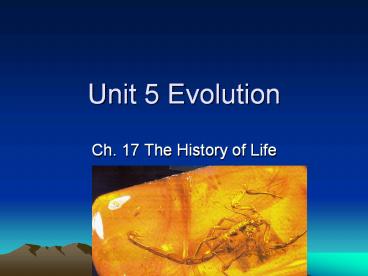Unit 5 Evolution - PowerPoint PPT Presentation
1 / 20
Title:
Unit 5 Evolution
Description:
Unit 5 Evolution Ch. 17 The History of Life Fossils & Ancient Life Paleontologists - scientists that study fossils From fossils, scientists can infer what past life ... – PowerPoint PPT presentation
Number of Views:127
Avg rating:3.0/5.0
Title: Unit 5 Evolution
1
Unit 5 Evolution
- Ch. 17 The History of Life
2
Fossils Ancient Life
- Paleontologists - scientists that study fossils
- From fossils, scientists can infer what past life
forms were like their structure, what they ate,
what ate them, the environ. where
they lived
3
Fossils Ancient Life
- They group similar organisms together arrange
them in the order that they lived, from oldest to
most recent - Together, all this info. about past life is
called the fossil record
4
Fossils Ancient Life
- The fossil record provides evidence about the
history of life on Earth - It also shows how different groups of organisms,
including species, have changed over time
5
Fossils Ancient Life
- The fossil record shows that more than 99 of all
species that have ever lived on Earth have become
extinct - Extinct - the species died out
6
Interpreting Fossil Evidence
- Relative dating - determining the age of a fossil
by comparing its placement with that of fossils
in other layers
7
Interpreting Fossil Evidence
- Scientists use radioactive decay to assign
absolute ages to rocks. - Radioactive elements decay or breakdown at a
steady rate which is called its half-life.
8
Formation of Earth
- Earths early atmosphere probably contained
hydrogen cyanide, carbon dioxide, carbon
monoxide, nitrogen, hydrogen sulfide, water
9
Figure 17-8 Miller-Urey Experiment
Secion 17-2
Mixture of gases simulating atmospheres of early
Earth
Spark simulating lightning storms
Cold water cools chamber, causing droplets to form
Condensation chamber
Water vapor
Liquid containing amino acids and other organic
compounds
10
Miller and Urey
- Miller and Ureys experiments suggested how
mixtures of the organic compounds necessary for
life could have arisen from simpler compounds
present on a primative earth
11
The First Organic Molecules
- Experiments have suggested how simple compounds
found on the early Earth could have combined to
form the organic compounds needed for life
12
Free Oxygen
- The rise of oxygen in the atmosphere drove some
life forms to extinction - Others evolved new, more efficient metabolic
pathways that used oxygen for respiration
13
Origin of Eukaryotic Cells
- Endosymbiotic theory - proposes that eukaryotic
cells arose from living communities formed by
prokaryotic organisms
14
Mass Extinction
- Mass extinction - when many types of living
things become extinct at the same time - At the end of the Paleozoic Era, a mass
extinction affected both plants animals on land
in the sea - 95 of life in the oceans disappeared
15
Patterns of Evolution
- Macroevolution - large-scale evolutionary
patterns processes that occur over long periods
of time - 6 important topics in macroevolution are
- extinction
- adaptive radiation
- convergent evolution
- coevolution,
- punctuated equilibrium,
- changes in developmental genes
16
Patterns of Evolution
- Extinction
- More than 99 of all species are now extinct
- It usually happens for a reason species compete
for resources, environments change - Some species adapt survive, others become
extinct
17
Patterns of Evolution
- Adaptive radiation - when a single species has
evolved, through NS, into diverse forms that live
in different ways - Ex.) Darwins Finches
18
Patterns of Evolution
- Convergent evolution - when unrelated organisms
begin to resemble one another - It has occurred in both plants animals
- Ex.) Swimming animals
19
Patterns of Evolution
- Coevolution - when 2 species evolve in response
to changes in each other over time - Ex.) Orchid has long spur with nectar in its tip,
a Hawk moth has equally long feeding tube that
allows it to feed on the nectar
20
Patterns of Evolution
- Punctuated equilibrium - a pattern of long,
stable periods interrupted by brief periods of
more rapid change































